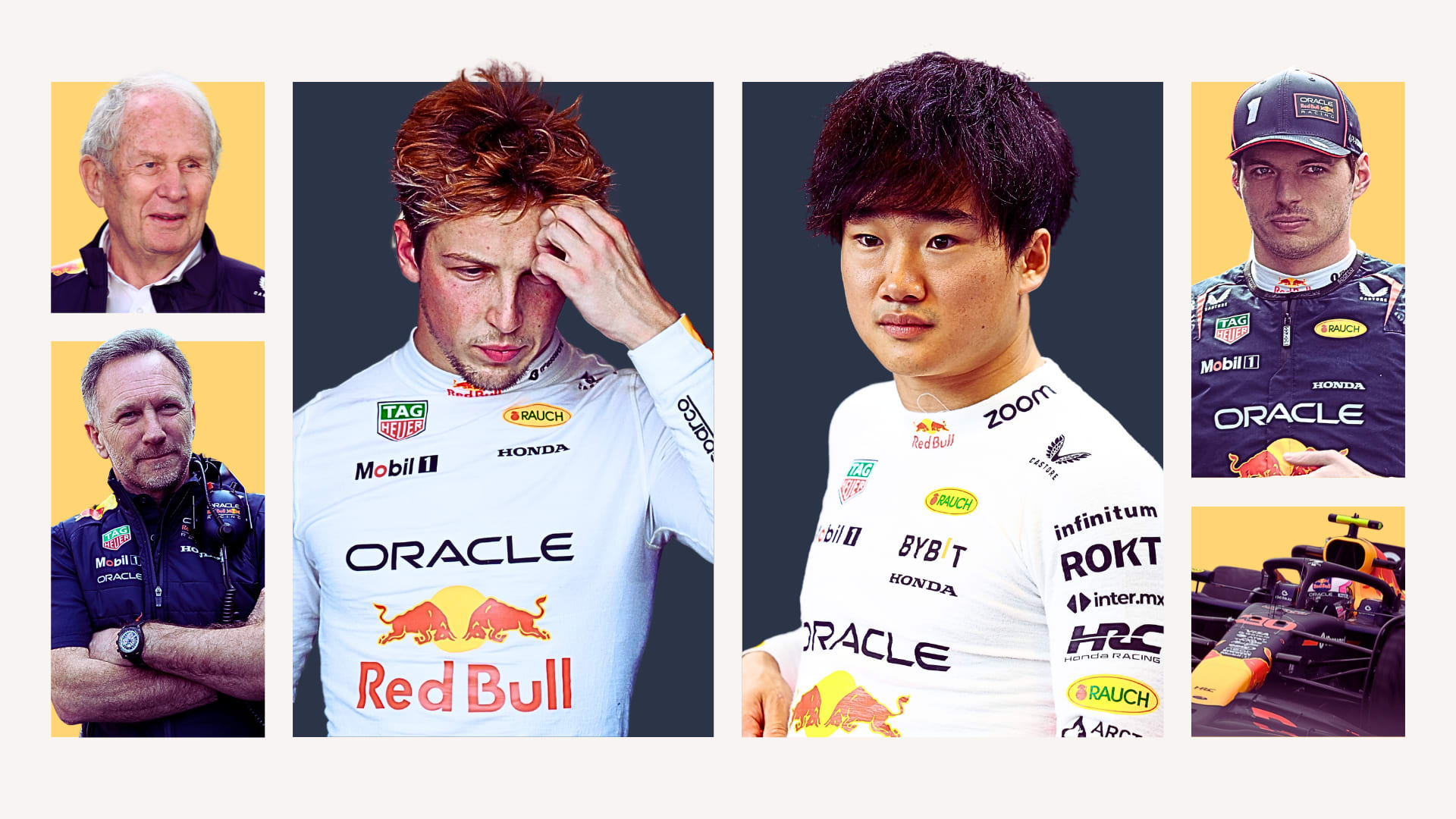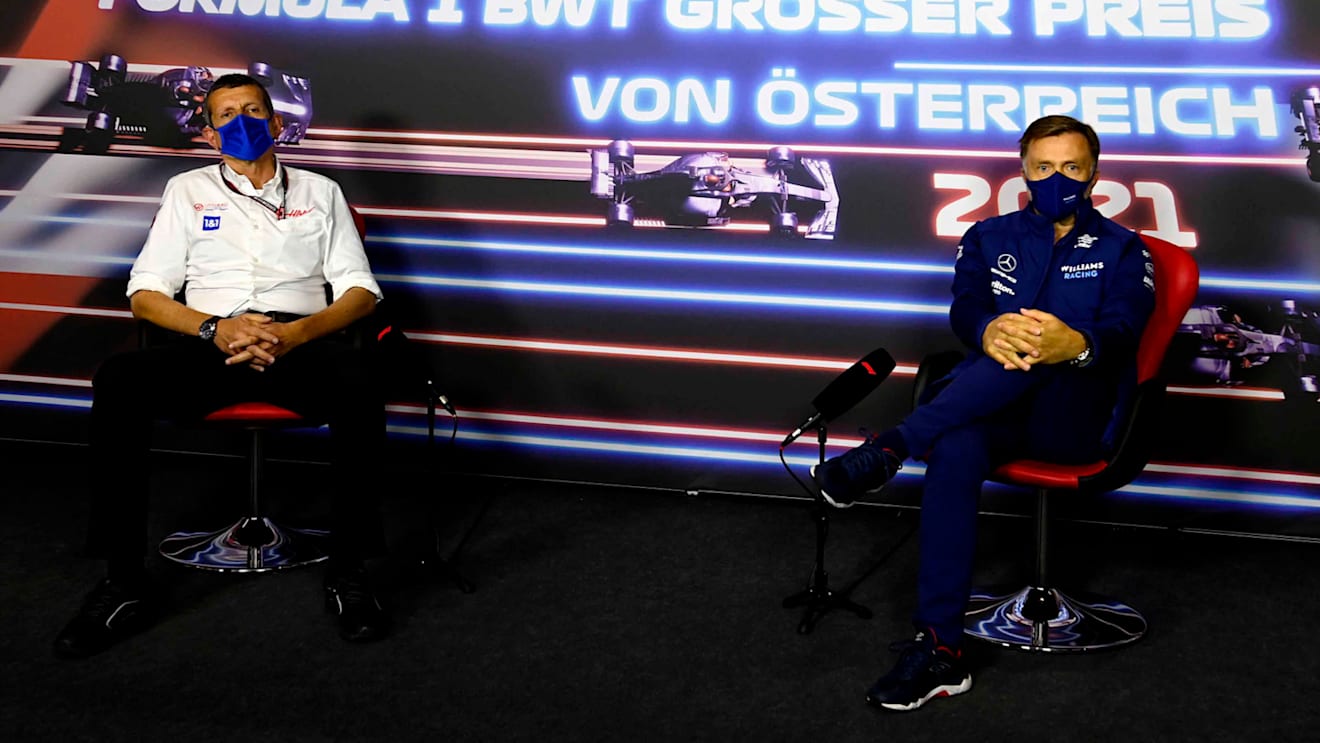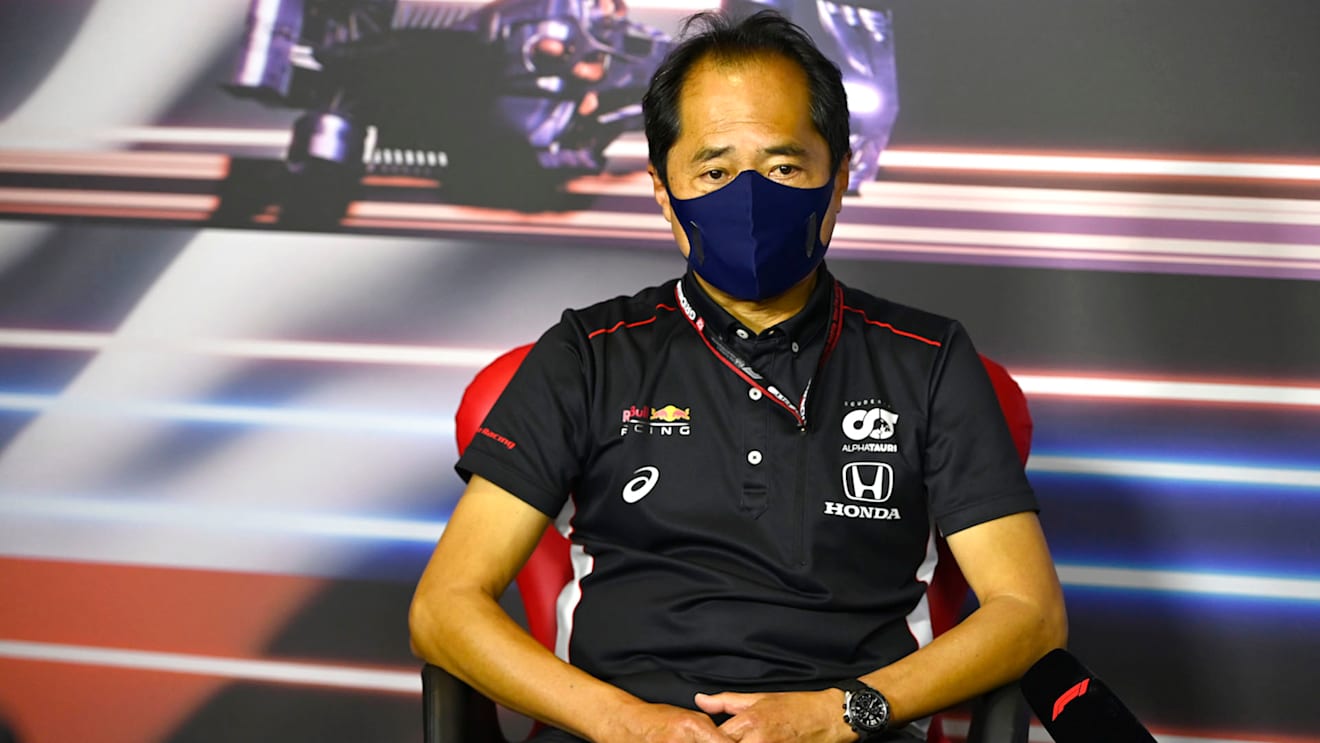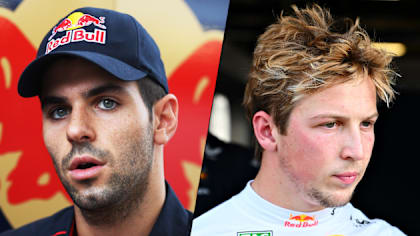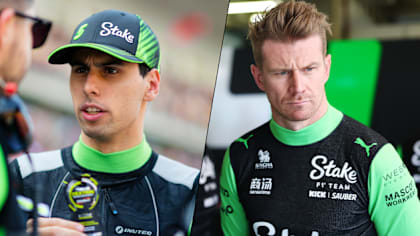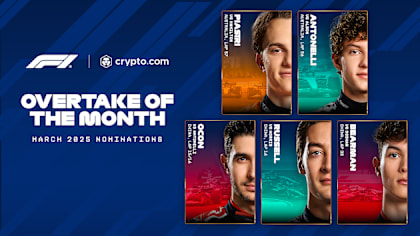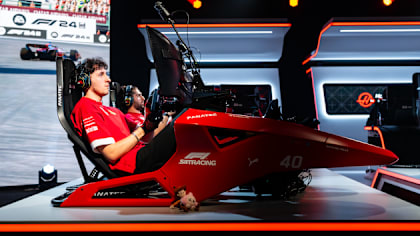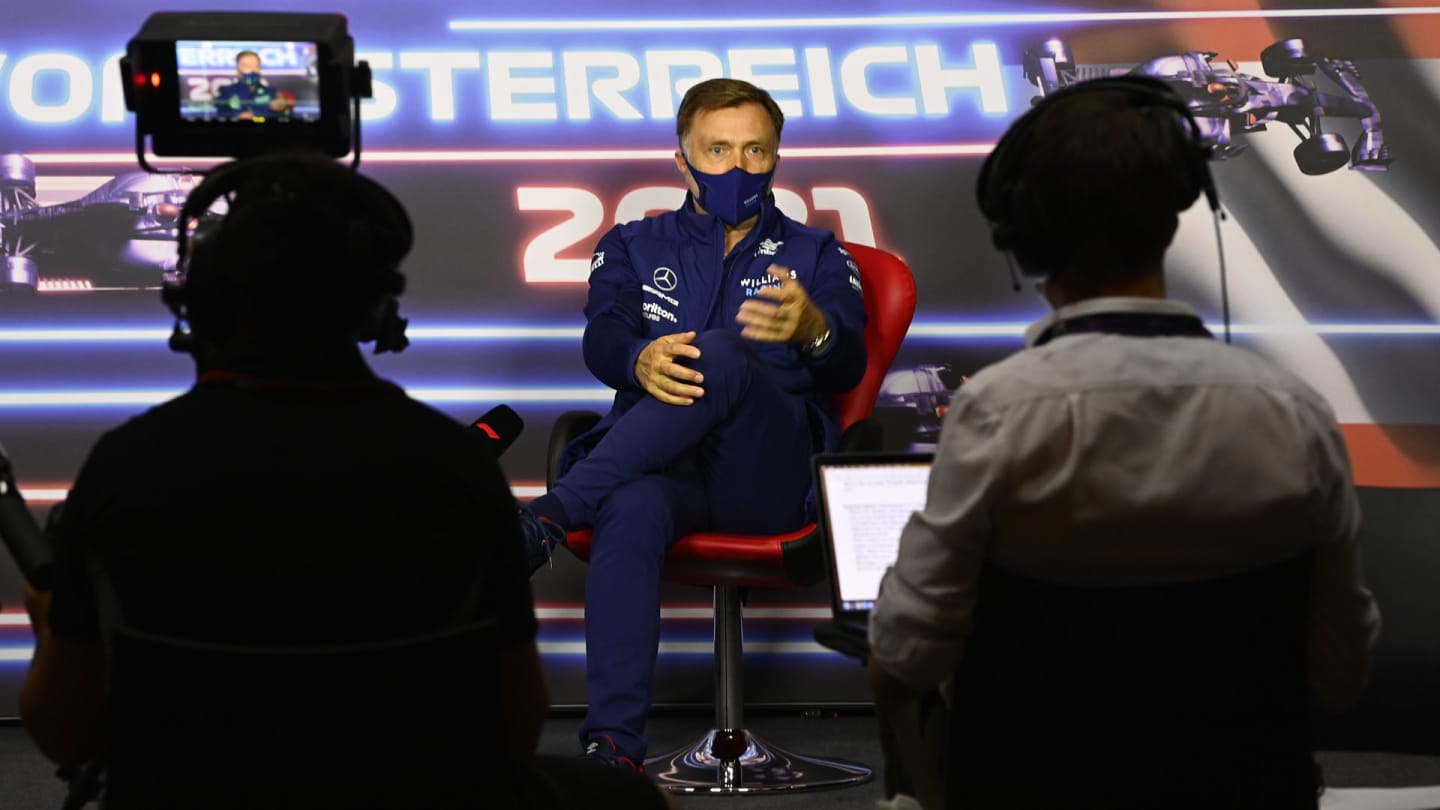
News
FIA Friday press conference - Austria
Share

TEAM REPRESENTATIVES
Guenther STEINER (Haas), Jost CAPITO (Williams)
PART ONE
Q: Jost, can we start with you. Very painful for George last weekend – but also very encouraging, because the pace was good, wasn't it?
Jost Capito: Yeah, it's both. Of course it was disappointing not finishing the race but to see the pace during qualifying and during the race was quite encouraging, yes, absolutely right.
Q: George’s mantra in the press conference yesterday was very much ‘what doesn’t break you, makes you stronger’. So, how’s the team bounced back this week? What’s the mood?
JC: It’s a different weekend but I think last weekend was encouraging to go into this weekend. We made the tyres work very well last weekend and I think some other teams will catch-up with that and look at that data and be better this weekend as well. It will be a new challenge. We’re in a positive mood towards this weekend.
Q: Tell us a little bit more about the tyres this weekend. We’ve got the softer compounds here, the C5 is here. Did you do much running with that tyre in FP1?
JC: Nicky did one set of the test tyres. Now we are just after the session so I don’t know the data yet but we’ll see.
Q: You mentioned Nicholas. He said yesterday that he’s not thinking about 2022 yet. When are you going to make a call on his future?
JC: On the drivers’ side we’ve got time at the moment. We will announce when we can announce the drivers but we’re not in a rush at the moment.
Q: Just tell us about Nicky’s strengths. What’s impressed you about him since you’ve been at the team?
JC: I think his dedication and his will to get better. How he practices and how he approaches the races, how he approaches the season is really impressive. He had his rookie season last year and that was big for a rookie, a very difficult season last year for a rookie with all the COVID restrictions, new tracks and everything different than normal. Obviously this year he improves a lot in his second season. His confidence level is quite high and his race speed is very impressive. He is working still on getting better results from qualifying but he was very close to Q2 last weekend and let’s see what he can do. I’m sure he can still improve during the season.
Q: Can you tell us any more about the timing? We’re into July now. When are you expecting to make a call on that? Or will you wait until after the season?
JC: I don’t think we want to wait until after the season – but at the moment we’ve got time so we have no timeline when we want to announce what. It also depends quite a lot what happens with George. We’ll see.
Q: Just a word of what’s going on back at the factory? Is it all towards 2022 now or is the team in a state of limbo? Because you’ve had all of these structural changes recently – is it all geared towards next year or will we start seeing the fruits of the labour this season?
JC: Mainly, we’re working on next year’s car. So, that didn’t change and that was before we did the changes and it’s still the same now. So still, when we tried something obvious on this year’s car, of course we improve it but structural changes are not just for one car and not for the other. I think we are working differently right now and that has an impact on this season as well. I think part of the performance we’ve got right now is based on the structural changes and on the different kind of work we are doing and the different kinds of cooperation within the various departments.
Q: Is that mainly operational at the track, is that what’s changed?
JC: No, it’s in general. It’s cooperation between the track team and the home team that changed, mainly. And that’s something that you feel immediately. There is a better communication.
Q: Guenther, one of the topics that came out of yesterday’s press conference was Nikita having a heavier car than Mick. Can you just explain to us how one car can be heavier than the other?
Guenther Steiner: It’s in the tolerances. It’s pretty easy to explain. You always try to do your best and one of the chassis is a little bit heavier but not in all circumstances – just when we need a certain weight balance, so it ends up a little bit heavier. It’s marginal – but it is heavier.
Q: Can you give us any numbers? How much heavier?
GS: No, I don’t want to get into numbers – because then we are quoted on numbers and then we go and discuss numbers – because they can vary depending on the racetrack, and the racing because, as I said with the weight balance we need to achieve.
Q: Heavy enough to have an impact on lap time or tyre wear?
GS: Absolutely, it also has an impact. Heavier cannot have no impact. It’s physics. Again, the next thing you ask me is how much impact? Give me a time! I’m not going to go into there because then we start to speculate because it’s not one fixed number.
Q: Is Nikita going to get a new chassis any time soon?
GS: Yeah, the plan is to have a new chassis for Belgium for him.
Q: On the topic of Nikita. Can you just explain something that I think happened yesterday. He gave you a door. What’s the story behind that?
GS: Apparently, in Russia, if you get a present, you need to give a present back. So, we gave him the present of the Mazespin, of this game, so his present back was the door. The door was a present because of last year, or two years ago, because of what happened with Kevin and… with Kevin – Romain was not involved in that one, he was the good guy this time, Romain. So, what happened with Kevin two years ago, so he thought I needed a new door.
Q: A reinforced door! Now, we’re back at the same racetrack as last weekend. Can you tell us how much of a good thing that is for your drivers – because it’s all about learning Formula 1, so coming back to the same place, is that a good thing?
GS: Absolutely. I think at least they have got more data to look at, to learn what they did last weekend, how can we get something out of it and then re-test it here, which you can use it always as a test session because we stay at the same track. Obviously we change tyres, I know that, but some of the tyres stay the same, and the temperatures have changed but in general I don’t think it’s a bad thing for us, it’s a good thing when you stay at the same race track and can go again.
Q: And what about the blue flags. Let’s look ahead to this weekend’s race. Nikita in particular was very interesting yesterday, talking about the impact of blue flags on his races and back at Monaco I think he said he had 35 blue flags during the race, so he could never settle. What advice, what can you do to help the drivers in that situation?
GS: It’s very difficult. On the short tracks like this and Monte Carlo, when you have a car like us that’s pretty slow, you get these blue flags and the only way you can try to help is with the strategy, which we did last weekend. We tried to get him out of the first round of blue flags. He couldn’t avoid the second one, the second train unfortunately, so, as he explained, once you get one or two, you’re just so slow you can never recoup the tyre back to a performing state, so you just fall into the trap of all the blue flags that are coming. It seems like, all the other guys, they were in a train as well, somebody was in front and they didn't let anybody past and he got just caught-up there and then you’re tyres are working and then you’re just out there sliding around. Mick got a little bit luckier with his strategy and he could stay in front of, I think it was Ocon which was fighting with Leclerc a little bit, so they stayed away, so he just got a few blue flags in the closing laps of the race. It is difficult. Especially these short tracks. They are terrible. I mean, I feel for them, but whenever you see them and watch them it’s like ‘whoa, here we go again’.
VIDEO CONFERENCE
Q: (Dieter Rencken – Racing Lines) Question for Guenther. About the Nikita chassis situation. Could you confirm that you’ve actually swapped chassis between the drivers. So, Mick has actually driven this ‘so-called’ heavier chassis as well. I believe at one or two races. And then also, could you confirm that it’s heavier because this particular car was a carryover from last year – I believe driven by Kevin Magnussen and therefore it suffered various damages which had been repaired and therefore it’s a bit heavier than a brand new car?
GS: It seems like you know more about our chassis than I do Dieter! The chassis, I think it’s a tolerance and obviously we carried all the chassis over from last year, just to clarify that. Like a lot of other teams did because of the freezing of the car. The car is not a complete new-build. It is in the tolerance when you build a car. Car #1 has got tolerance prepreg so there is something in there and for sure over a year you do some repair jobs and maybe it got a little bit heavier there. And, back to your first question, which I almost forgot, I don’t remember. We swap the chassis around quite a bit and we always did so I don’t exactly know who’s driven which chassis when and where – but I think both drivers have driven all of our chassis.
Q: (Scott Mitchell – The Race) Question for Guenther on the subject of the blue flags. Obviously you talked a bit there about how much that is down to luck and, I guess, where you get caught on the circuit can have a massive impact on how much time you lose – but we’ve heard from backmarkers in the past in Formula 1 about how there’s almost a little bit of an art to making sure you don’t lose that much time under blue flags. Is this something you’re seeing your two guys get better at as the season goes on? Are they working out how to lose as little time as possible?
GS: Absolutely. Everything when we do it a lot – and it is not nice to do the blue flag things because you don't want to get lapped if you are a racer – but it is something that by doing it a bit you get better at it. I didn’t study the data if they got better, but going back to last weekend it was very… I mean there was I think 10 cars lapping Nikita within two or three laps, so there he cannot do anything any more because the tyre just doesn’t work anymore because you are going too much slow and offline and you pick up all the dirt, so he never can clean the tyre up. But for sure, doing it more and often, it will teach you some lessons on what to do and what not.
Q: (Alan Baldwin – Reuters) Question for Guenther. We heard from Sebastian Vettel yesterday about his, I suppose you’d call it mentorship of Mick Schumacher and the friendship that goes back a while. It’s a little bit unorthodox perhaps, two drivers from rival teams, rival engine suppliers being so friendly and helpful to each other – but perhaps you could give your take on how you see it?
GS: I think it’s a great thing. I don’t know how long they go back, I didn’t ask Mick that one but it seems they get on well – but even if they don't go back a long time and they get on well, why not? For sure, for Mick, it’s an advantage. I think Vettel is in the sport a long time and he feels attached to Mick and just tries to help him as much as he can to make him the next champion. I think it’s a great thing and I don’t see any issue with it.
Q: (Andrew Benson – BBC) Guenther, on average, your car is more than a second a lap slower than anything else this year – but Mick got it into Q2 in France and came close in Azerbaijan. Can you explain how impressive those performances have been; what sort of level you think he’s driving it; what sort of potential you think he has? Thank you.
GS: Obviously the car isn’t as fast because we didn't develop it, as you rightly said, so it is slower. Mick is just trying to put always the best in that he can. Also Nikita – but Mick’s got into Q2. I don’t know if he could have stayed there without the red flag, I cannot comment on that one because we didn’t get there – but it was a big effort. It is like we are making progress with the drivers. We know from the beginning that we have two rookies and for rookies, not having a reference is always very difficult, as we all know, because you cannot see what the other guy is doing. Or, you can see it – but the other guy is a rookie as well, so you don’t get the experience in. I think as a team we make progress with both drivers.
Q: Jost, can I bring you in to talk about George Russell please. He said in France it was one of his best races to twelfth. Brilliant qualifying here last week – just how impressed have you been by him and are there comparisons to be made with Kimi Räikkönen, of course, who you were instrumental in bringing to Sauber 20 years ago.
JC: It’s difficult to say. Compared to Kimi, it’s George’s third season, compared to Kimi, when I was there it was his first season. So, for sure it’s different. I’m still impressed by George. Even though the expectations were high, especially after last year and I think he fully delivers according to the expectations and, with all the things that’s going around him with his contract for next year and where he’s driving, I am very impressed how cool he takes it and how relaxed he is with that situation and how it doesn’t touch him. So, he’s fully focussed and he’s working well with the team. This is very impressive as well: how he works with the team, how he motivates the team. Every Tuesday we have a town hall, where we inform the whole company, everybody dials in, and is informed about the last weekend, and George dialled in on Tuesday and talks to the team. He takes his time to be with the team. He goes to the factory and the gym and he’s very close to the team and I think that is one of his strengths – because they all love him and they all work… everybody works very hard for him.
Q: (Dieter Rencken – Racing Lines) Question for Jost. Two, in fact. The first, obviously with Dorilton investing in the team and the upgrade of the facilities etc., how much are you hampered by the fact that the budget cap contains a cap on capital expenditure. And does this in any way affect your plans going forward? The second part of the question, regarding George, how frustrating is it to have no particular timeline on the driver, that you’re waiting for an outside party to decide what his future is before you can react?
JC: Okay, first to the first question. Dorilton did a lot of investment at the end of last year, so before the cost-cap came in. And I think we’re very happy with that and we are not… of course we will be restricted by the cost-cap but at the moment we are working well within the cost-cap. And I think for the future as well. It’s very important to be efficient for the future and I think that’s what we are working on, to become even more efficient in all areas that we have more resources to put in the performance and into the factory. The second is I’m not really bothered. I think that at the moment we, as a team, we are moving on quite well. The changes seem to work pretty well, that we have done. George is very happy. He is focused on driving this season. I see more and more interest from drivers to drive for Williams in the future. They see there is a proper financial backing and they see that the team is really willing to move forward and this really attracts drivers as well. I think the longer we wait the better the situation we will be in.
Q: Have you had a lot of driver managers ringing you?
JC: I wouldn’t say a lot. Normal business.
Q: (Andrew Benson – BBC) Jost, Williams seems to have made a significant step forward this year, Q2 seems to be a default position now. Can you explain how you have managed to do that. Secondly, Nicholas has halved to George compared to last season, over the first races of this year. Can you explain how he has managed to take that step forward please?
JC: I think the first thing is it’s difficult to say. I think we changed the management style. We changed how we work. I think if you were in the paddock I think you would see a different mindset, a different working style. That’s what we changed. I think the team worked hard over the winter, before I arrived, and that’s part of the positive step as well. The second, with Nicky: I think it is difficult to have a team-mate like George who is exceptionally good in qualifying. I think everybody knows that and Nicky’s driving his own qualifying now and he’s not that much focused on what George is doing and he is improving on his own. And last year all the tracks, in a Formula 1 car, were new for him. This year he comes to tracks where we have been last year so he is much more confident, so yeah, I think we will see quite good results also from him in qualifying during the season.
Q: (Scott Mitchell – The Race) Jost, just on the performance and progress of the team this year. Is the performance step along enough of a boost and a validation of the work that is going on behind the scenes or do you feel that the team needs a more tangible result such as a Q3 appearance or indeed, scoring points?
JC: I think that would all help. George was very close to Q3 last weekend and of course everybody would love to get the car into Q3 but I think it’s not what we expect. What we expect is to get to a certain point where we get some points. The last race has shown that it’s possible and I am absolutely convinced that we will get some points this season and when we have some points that will be another boost for the team. I think last weekend was quite successful for us, even if we didn’t finish the race with George in the points but the whole team sees that we are capable and it is quite a big boost and when the first points come I think that will be even another boost for being even more competitive.
Q: (Dieter Rencken – Racing Lines) In a fortnight we see the first spring qualifying. Do your teams have any reservations about the structure or the financial aspect or any other angle of this sprint qualifying or are you happy to go ahead with it in a fortnight’s time.
GS: As I always said I am very happy to go ahead with this. It’s something we need to try to see if it works, if it is good, if the spectators, the fans like it. For me trying it… it’s good obviously financially, it could go one of the other way, we don’t know that, but every race can go that. It’s just one of those things to take a little bit of risk. My hope in the end is that this is a good format which we can carry on for next for some more races and that people like it because we are racing for the fans. We are not racing for ourselves because we like it. We need to put a race on that as much as possible people watch. Let’s see. We have got only two weeks to wait and then we have the first one going on and we will see what the feedback is.
JC: I think Guenther says a lot and I'm fully agreed with this. Everybody who knows me knows that I am always willing for changes, doing something new and trying something new. I think that it is a very good move for Formula 1. It adds something on Friday that is exciting, instead of just having free practice. It’s somehow a qualifying as well for the qualifying race. On Saturday there is something different for the fans. The fans have seen the same format for many years and I believe it is time for a change or an update. I think it’s really good to try it for three races and then analyse it and see if the fans like it or not and if the fans like it then I think we should go on with this.
Q: (Christian Nimmervoll – motorsport.com) Question to both: I know you are not involved in tomorrow’s manufacturer meeting about the future engine regulations but do you have an opinion on terms of should Formula 1 be open for a significant change in that are in order to make new manufacturers potentially enter F1?
JC: Yeah, I believe it needs a significant change because when you look where the automotive industry is going to, the CO2 discussion is an issue and I am absolutely convinced that Formula 1 has to go to zero CO2 as well from 2025 but there are more technical options than just full electric. E-Fuels is something that has to be investigated, has to be looked at, and also in combination with hybrid. In my view these systems and technology have a future on mobility and therefore I think the regulations should go in that direction but should investigate all options and therefore it is right that car manufacturers have to be part of the discussion. They have to be attracted to the new regulations or they wouldn’t join.
GS: What Jost says is completely right. We need a change. We need to go to zero. I hope it comes sooner rather than later. As you said, we are not involved in the discussions as Haas is not a manufacturer of engines or the technology. I hope they find a solution and that the solutions mean that more manufacturers can get into it, because at the moment for anybody coming in with the technology we have got now it’s very difficult because it is very sophisticated and very difficult to achieve. Hopefully they will find a compromise and there is all the big boys here to try to decide on what is best going forward but I hope they come up with a solution that makes us all happy and makes Formula 1 happy.
Q: (Scott Mitchell – The Race) Guenther, Sebastian said yesterday that as an observer of what Mick’s doing, he’s been impressed by what he has done on track. But he’s also impressed by how Mick has taken to F1 off-track as well. He feels that Mick is doing all the right things, finding ways to enjoy it and working hard and he said he also thinks he might be lifting the team as well. Is that the vibe you get inside the team? Is Mick taking on a good amount of responsibility? Is he showing the right confidence off track?
GS: Yeah, as I always said, I think I am impressed by his work ethic. He is working all the time on it. We appreciate it in these times, because this year we are where we are with the car, you know. He does everything possible to keep the team motivated and gives them the confidence as well that we will be in a better place going forward. I appreciate it a lot from him that he helps you doing that, and he is doing it as a young man. Very respectable what he is achieving. Also, to me, it seems like Sebastian said, he seems to be enjoying what he is doing. For him it’s not that he has to force himself. This is what he wants to do, in my opinion, and I respect that a lot.
1 / 6
TEAM REPRESENTATIVES
Toyoharu TANABE (Honda), Franz TOST (AlphaTauri)
PART TWO
Q: Franz, can we throw it back to Sunday? What was your reaction to Pierre’s clash with Charles Leclerc and how surprised were you that the stewards didn’t take a look?
Franz Tost: First of all, it’s always a big shock when after a couple of hundred metres one car is more or less out of the race because of a crash and yeah, Pierre came in but the rear left tyre was so destroyed that also the suspension broke and we couldn’t send him out any more. It was a shock, because we were very competitive and I think he could have finished easily in the fifth or sixth place. But this is racing. This can happen and Charles didn’t do it deliberately because he destroyed his front wing and he had to come into the pits. Therefore, for me, after the race it was gone.
Q: So a racing accident?
FT: Racing accident. The stewards made this decision. I was a little bit surprised to be honest but it’s the FIA’s decision and there is nothing more to add. We respect it and that’s it.
Q: You say the car was competitive last weekend, so let’s look at the positives. Where is the car good, particularly around this Red Bull Ring and is there anything you can do to make it even more competitive in the race than it is in qualifying?
FT: Yeah, in the first race, in qualifying we lost a lot of time in corner three and I hope that the engineers found something there to improve the behaviour of the car under acceleration. Also corner four we were not so good. But it looked quite positive today in the first free practice. And regarding the race I hope that the lower temperatures will help us, because our race pace did not match our pace in qualifying and we were too slow in the race. The engineers analysed what to do and I think that also there they found a good solution and therefore I am quite optimistic for qualifying and the race this weekend.
Q: Can we have a look at Yuki Tsunoda now? Back in the points on Sunday and good today in FP1. Have you seen a change in him in the last few races?
FT: Well, Yuki is a rookie and he is coming new in Formula 1 and I believe for these young drivers it is really difficult to come into Formula 1, because at every race track on every race weekend they do the first time their qualifying there. Of course you can say they did FP1, FP2, FP3 they must know where to go. But, for example, the wind is increasing or coming from a different direction or the track is hotter or colder, so many things are changing. When I remember back to the accident in Paul Ricard, when Yuki crashed, we had some understeering problems in FP3 and we decided to give more front wing to do the work on the front suspension. He came to this corner, turned in, and then the car reacted a little bit more than he expected, came over the kerbs and there was also some wind direction change and he crashed. You cannot teach this to a young driver, he has to learn in every qualifying session what to do on this track and therefore experience is so important. Yuki is improving really well and the complete process is absolutely in the right direction. He didn’t change the approach. He already had a good approach. But as he is now, he has much more time with the engineers, because he is living in Faenza. Every day he is spending hours with the engineers. This helps him to understand the car from the mechanical side, from the aerodynamic side, how to use the power unit. The power unit is not only giving you the power, it is helping under braking, with the MGUK and so on and so on. The young driver has to learn this. But it is not only for one track always the same. Every track in a different way how he can use the power unit. And there are different corners and you can’t expect that a rookie knows everything from the very beginning onwards. That’s why I always say a young driver needs three years to understand this complicated Formula 1, because Formula 1 has become much more complicated than it was years before. I am very happy with Yuki;. He shows fantastic natural speed and he is improving day-by-day, session by session and I am quite optimistic that we will see a very good second half of the season and that Yuki will also be successful in the future.
Q: Yuki revealed a nice detail yesterday in the press conference when he said that Checo Perez has given him some advice and they’ve exchanged text messages earlier in the year. Has it been common practice for the senior drivers in the Red Bull programme to help the younger ones?
FT: It was always the case in the past that the two drivers worked together because they are coming from the same family but it’s really positive if such an experienced driver like Pérez or Max is giving some advice to the young drivers. This helps enormously because they know exactly how to help them and where to advise them in the correct way.
Q: Tanabe-san, you’ve won the last four races with Red Bull Racing. Just how much belief is there inside Honda that you can now win the world title?
Toyoharu Tanabe: Actually, we finished one third of the races in this season and then the result is from the first race is not too bad but we know Mercedes how strong they are and then they will come back with a strong car in the future, for sure. So, to improve our performance Honda Sakura members and the Milton Keynes members, along with teams, working very hard to improve our trackside performance. And then, to keep challenging the championship for this year.
Q: There’s been a lot of speculation about the power of the power unit that you introduced in France, some people saying as much as 15 brake horsepower more. Is that true?
TT: I’m very happy if it is true but it’s no true. Under current regulations, any performance update is not allowed to apply during the season. As a result, our second PU is the same as the first PU in terms of specification and performance.
Q: And what about AlphaTauri? Franz is sitting next to you; what do you think of their performance?
TT: We have been working since 2018 and then we worked together and then we are very happy, their car is showing good performance in this year and then as a result Pierre got sixth position continuously in qualifying so some good races, some bad races, but we are very happy to work with AlphaTauri for both drivers, and then Franz and the engineers, mechanics.
Q: You’re enjoying so much success this year. Do you regret that Honda is quitting at the end of the season or could the decision change if you win the World Championship?
TT: Personally, yes but regardless the result of this year’s championship or our result, I think Honda’s decision has been not changed from their previous one. It means leaving from the Formula 1.
VIDEO CONFERENCE
Q: (Andrew Benson – BBC) Tanabe-san, on the engine and the second unit that you’ve introduced, do the reliability changes that you’ve made enable you to run the engine in a more performing mode more often? For example, can you chose a higher performance mode for qualifying and race than you were able to before because of the reliability changes? Is there anything that could have explained this apparent improvement in straight line performance that Mercedes think they’re seeing, for example?
TT: The current performance improvement is as a result from the hard work from Honda and the teams. Then under the current PU regulations, we need to submit any changes, so only allowed to change for reliability, for cost reasons and logistics. Then we need to submit very detailed to the FIA first and the FIA approves those changes. FIA distributes all the documents to the other PU manufacturers, so we need to have an approvement (sic) from the other PU manufacturers to change any single parts, specification. Then, why we are doing such a very much detailed investigation is a long time ago some teams improved their performance to make a change, to improve their reliability, so we are very careful to change the performance and then it is not possible to improve the performance during the season. That’s my answer to that suspicion.
Q: (Christian Nimmervoll – Motorsport.com) Tanabe-san, do you feel that Honda, at the end of the year, will be leaving F1 with the strongest engine?
TT: We keep analysing our position, compared to the other PU manufacturers, so that analysis, including the chassis performance as well, so if you have a good car with less downforce, sometimes you see a good engine power performance, so it’s a little bit difficult to judge. Then our current results give us a… still we are not number one so as I said, we cannot improve the pure performance, like the IC performance, then we are working on very hard how to use the PU efficiently at the track, so we want to use current hardware more efficiently with team engineers.
Q: (Scott Mitchell – The Race) Tanabe-san, based on your answers there, is it fair to say that the total output of the Honda engine hasn’t changed with the second unit but you’re extracting more of the potential that was there from the beginning?
TT: I can yes, so because we started using this ‘20/’21 new PU from pre-season test and then we have been learning gradually how to use our PU and then we improve our weakness and then we push our strengths and then as a result the base specification, the performance is the same but trackside performance, I believe, we have been improving.
Q: (Dieter Rencken – Racing Lines) Tanabe-san, could you confirm please, that next year’s engines for Red Bull and AlphaTauri will in fact be supplied from Sakura and not from the Red Bull operation in Milton Keynes?
TT: Yes. Red Bull and Honda have been working on that project and then so how to proceed that transition for next year. I cannot tell the detail but generally we are going to a good direction and then we should prepare well for next year so now we are working very hard, I am working very hard at the trackside.
Q: (Chris Medland – Racer) Franz, just generally Franz, what has the last twelve months been like for a team principal point of view, since the late start of last season, how challenging has it been running your team during the pandemic with so many races, we’ve now had 26 in the last 52 weeks?
FT: It was challenging for all of us because of this COVID story and because of the restrictions we face every race weekend. Challenging yes, but we don’t have it under control, for example in England or in other countries and you don’t know if there is a new version of this COVID virus coming, a new mutation, the Delta and so on, and then you plan something but you read then or hear there’s a change either from the organisation side or from the logistic side or anywhere else. This makes it difficult. The race itself, the teams are used to go there and also the number, this is not a problem but to keep everything together and to calm down with the people if there’s another change and to motivate them, I think this is the biggest challenge all the team principals face.
Q: (Andrew Benson – BBC) Tanabe-san, you said just then that the base specification on performance is the same but trackside performance I believe we’ve been improving. Can you explain in what ways you’ve been able to improve the trackside performance of the engine within the constraints of the regulations and not being able to improve the base spec?
TT: So when we understand this year’s PU, ICE and the ERS system and then we go to different tracks every time, so we simulate how to use the balance for the ICE and the electric systems so then we optimise the usage of the PU in terms of the lap times, so current technical directives give us a little bit harder time, we need to use qualifying, race, the same mode, we need to run in qualifying and the race the same mode, so that time of simulation and then when we come to the track, we run real world and then update that type of calculation to maximise our performance.
Q: (Scott Mitchell – The Race) Franz, just on Yuki’s progress: yesterday we were talking to him about the difficulties for rookies to adjust to blue flags in F1; it’s something I’m guessing Yuki hasn’t had to deal with it at any other point in his career. I just wondered, you’ve had so much experience with rookies, how difficult is it for them to get used to blue flags and is there an art to losing as little time as possible in that process?
FT: That’s quite difficult, progress because it’s from race track to race track different and of course we explain to the drivers beforehand where they don’t lose so much time and how to do it, but in the race, some times it’s coming in another way, they may be fighting with competitors just around them and then they get the blue flag. You don’t want to lose too much because then the other competitors behind you gets in a position to overtake you but of course you want to give the faster car, the leading cars, the free line and it’s also a question of experience, which is what I mentioned before. The rookies have to learn so many different things and the blue flags is one of those and you can lose two or three seconds immediately but if you manage it in a correct way and if you know how to do it then it’s maybe five to seven tenths but it’s a learning process and it’s not the same at every race track. This is also an important factor.
Q: (Dieter Rencken – Racing Lines) Franz, the Red Bull Junior drivers have generally had a sort of a rolling contract where you can exercise the option on their services at the end of each year. Pierre Gasly wasn’t one of those. Has he now reached the end of the cycle? In other words if he drives for you next year, is he on a completely new contract or would he actually be free to go somewhere else from the end of this season?
FT: But Dieter, you know as a professional that this is confidential. Sorry but I can’t talk about contents of contracts. I just tell you that I hope that he will be with us next year.
Q: (Andrew Benson – BBC) Tanabe-san, just on the engine, is it true that after the pre-season tests you had to run the engine in a lower performance mode because you had reliability concerns? And that therefore the reliability changes that you made for the second PU have enabled you to run it back again at the higher performance level now?
TT: No. How can I say? Maybe someone compared the GPS data from the first one to the second one. They easily can find out the gap between Mercedes, Ferrari, Renault and Honda. That’s the easiest way to find out how to use our PU – Honda uses PU from the beginning of the season.
YOU MIGHT ALSO LIKE
News ‘He’s not become the worst driver in two races’ – Ex-Red Bull junior Alguersuari sympathises with Lawson after Racing Bulls demotion
News Bortoleto ‘not proud’ of Lap 1 spin in China as Hulkenberg rues impact of early damage on ‘very tricky’ day
FeatureF1 Unlocked Crypto.com Overtake of the Month – Vote for Your Favourite Move Now!
Video LIVESTREAM: Catch all the Round 12 action from the season finale of the 2025 F1 Sim Racing World Championship
